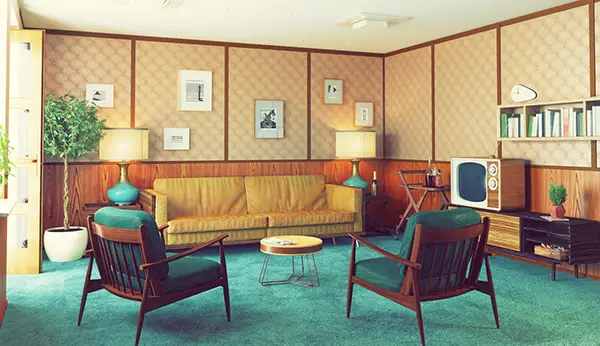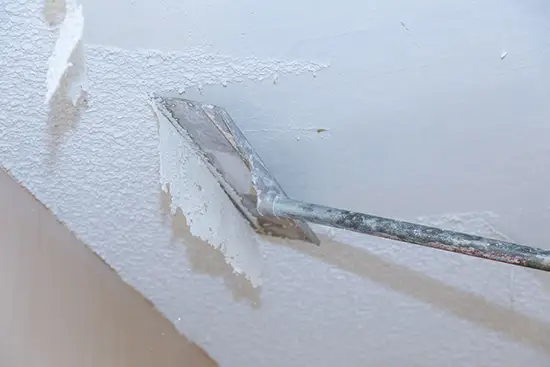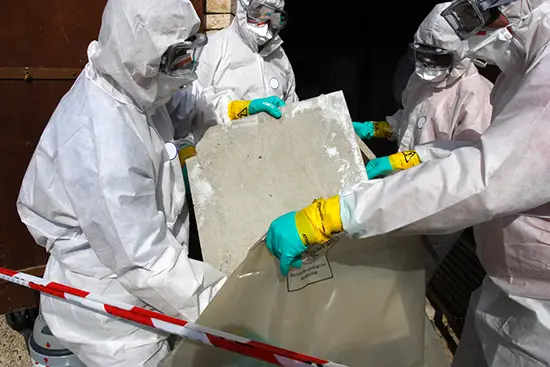Pros and Cons of Popcorn Ceilings in Real Estate
Published on September 18, 2023 | 8 Minute read

Melanie
Ortiz Reyes
Content Specialist
We all know that home design trends tend to come and go. One trend that has garnered some recent attention is the popularity of popcorn ceilings. Popcorn ceilings, also known as acoustic ceilings, cottage cheese ceilings, or stucco ceilings, were once a popular choice in home design, celebrated for their practicality and ability to hide imperfections. Once a common feature in homes, over the years, these textured ceilings have fallen out of favor for various reasons and are typically considered outdated and unappealing by many homebuyers. However, as with many design trends, there seems to be a hint of nostalgia in the air. So, are they truly making a comeback, or are they just a passing fad?
Popcorn ceilings first gained popularity in the mid-20th century, particularly in the 1950s and 1960s, and were introduced as an innovative solution to address several concerns related to home construction and design during that era.

Pros of Having Popcorn Ceilings
Noise Reduction
Popcorn ceilings have a textured surface that contains irregular patterns and small, rounded bumps. This uneven surface helps to scatter and disperse sound waves rather than allowing them to bounce back directly into the room, serving as an acoustic buffer. This is particularly beneficial in large spaces with high ceilings, such as living rooms, dining areas, or hallways, where sound can bounce off walls and ceilings, causing unwanted noise.
Hide Imperfections
The irregular patterns of popcorn ceilings can effectively camouflage minor imperfections, such as small cracks, dents, or uneven surfaces. The texture distracts the eye and diffuses light, making imperfections less noticeable.
Applying the textured material typically involves spraying or rolling a mixture onto the ceiling. This process creates a stippling effect that helps to break up the flat, uniform appearance of a smooth ceiling. As a result, flaws like uneven drywall seams or minor blemishes are less visible. Popcorn ceilings are also effective at concealing stains and water damage. The textured surface can hide discolorations or watermarks that might be difficult to remove or repair on a smooth ceiling.
They can also add a layer of durability. It can help protect the ceiling from minor scuffs, scrapes, and wear and tear, which might otherwise be more noticeable on a smooth ceiling.
Affordability
One of the primary reasons for the popularity of popcorn ceilings was their cost-effective installation. Applying the textured material to ceilings is generally less labor-intensive and time-consuming than achieving a smooth, finished surface.
The materials used for creating popcorn ceilings, such as spray-on or roll-on texture compounds, are inexpensive compared to other ceiling finishing options like intricate plasterwork or decorative tiles. This makes it an attractive option for builders and homeowners looking to save on construction or renovation costs.
Aesthetic Variation
Popcorn ceilings come in different textures and patterns. While the classic popcorn texture is characterized by its bumpy appearance, variations exist. Some homeowners opt for a subtler texture, while others prefer more pronounced patterns. This variety allows homeowners to choose a surface that suits their aesthetic preferences and complements their interior design.
Popcorn ceilings can be customized further through paint. Homeowners can paint their popcorn ceilings in various colors to match or contrast with their interior decor. The textured surface can add visual interest to a room by creating contrast and depth by absorbing and reflecting light differently based on the paint color, contributing to the room's overall aesthetic. While popcorn ceilings fell out of favor in the late 20th century, design trends are cyclical. These ceilings are attractive to those who appreciate retro or vintage aesthetics and to those who grew up in the 1950s-1980s. This connection to a specific era can evoke feelings of nostalgia. Some homeowners and interior designers intentionally maintain or restore popcorn ceilings as a design choice to create a unique, period-specific ambiance in their homes.
Cost-Effective
Homeowners on a budget may find popcorn ceilings attractive due to their affordability. Popcorn ceilings are a cost-effective option compared to other ceiling treatments, such as smooth finishes or decorative plasterwork. This affordability can be particularly appealing for those looking to renovate or update their homes without breaking the bank.

Potential Drawbacks
Despite the growing nostalgia and cost-effective appeal, it's important to consider some potential drawbacks of popcorn ceilings. First and foremost, asbestos in older popcorn ceilings can pose health risks. This discovery led to a heightened concern among homeowners and a desire to remove or cover these ceilings. If your home was constructed before the 1980s, it is advisable to have the ceiling tested for asbestos before any renovation or removal attempts.
Aesthetic Concerns
One of the primary reasons why popcorn ceilings have fallen out of favor is their aesthetic. Over time, homeowners' tastes have evolved, and many now find the textured, bumpy appearance unattractive and outdated. Smooth, sleek ceilings have become preferred for a more modern and elegant look.
Maintenance Challenges
Popcorn ceilings pose several maintenance challenges that contribute to their declining popularity. Textured ceilings tend to collect dust and cobwebs, making regular cleaning tedious, and repairing popcorn ceilings can be challenging. Any damage, whether from a water leak or other issues, may require a patch that is difficult to blend seamlessly with the existing texture.
Home Value
Homes with popcorn ceilings can sell for less than those with other ceiling finishes or more modern design features. The impact on the selling price can vary depending on several factors:
- Location
- Age of Home
- Condition and Appearance
- Buyer Preferences

How to Remove Popcorn Ceilings
If you're considering removing popcorn ceilings, it's imperative to approach the task with caution and care, especially if asbestos may be present. Asbestos testing typically costs between $200 to $400. If asbestos is found, removal becomes more complex and expensive due to safety regulations.
While some homeowners attempt popcorn ceiling removal as a DIY project to save money, it's essential to consider the risks, especially if asbestos is present. If this is the case, hiring professionals to remove popcorn ceilings is recommended. Labor costs can vary, but you might expect to pay anywhere from $1,000 to $3,000 or more for labor, depending on the complexity of the job.
If you decide to make this a DIY project, here are the general steps to follow:
- Gather Materials - You'll need materials such as joint compound, primer, and paint for ceiling repairs and finishing. The cost of materials can range from $50 to $200, depending on the size of the area.
- Preparation - Clear the room of furniture and cover the floors and walls with plastic sheeting to protect them from debris and dust.
- Wet the Ceiling - Spray the ceiling with water to soften the texture. This makes it easier to scrape off.
- Scraping - Using a wide putty knife or a specialized ceiling texture scraper, gently scrape off the popcorn texture. Make sure not to damage the underlying drywall.
- Repair and Smooth - After removal, assess the condition of the ceiling. Repair any imperfections with joint compound, and sand the surface until smooth.
- Prime and Paint - Apply a primer to the ceiling, followed by the paint of your choice. Smooth ceilings are typically painted with a flat or satin finish.
- Cleanup - Clean up thoroughly, removing any plastic sheeting and debris. Proper disposal of the removed popcorn texture and any asbestos-containing materials is crucial. Contractors will typically include cleanup and disposal in their services, but it's important to confirm this.
After popcorn ceiling removal, you may need to repair the ceiling surface. The cost of repairs will depend on the extent of the damage and can add to the overall cost.
Keep in mind that depending on your location, there may be permit requirements or local regulations governing asbestos removal. Check with local authorities and factor in any permit costs if necessary.
Other factors that can affect costs include:
- The ceiling's height (vaulted ceilings may be more expensive).
- Accessibility (removing popcorn from stairwells can be challenging).
- Location (prices can vary by region).
While there appears to be a nostalgic resurgence of interest in popcorn ceilings, it's vital to approach their revival with caution and consideration. Many homeowners are drawn to this ceiling treatment's textured charm and cost-effectiveness, while others consider them outdated and undesirable.
Whether popcorn ceilings make a full-fledged comeback or remain a passing fad will depend on personal preferences and evolving design trends. If you're contemplating incorporating popcorn ceilings into your home, consulting with a professional contractor or interior designer can provide valuable insights and help you make an informed decision that aligns with your vision and goals for your space.